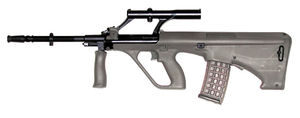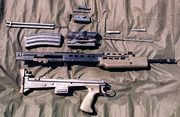Bullpup

Bullpups are firearm configurations in which both the action and magazine are located behind the trigger and alongside the shooter's face, so there is no wasted space for the buttstock as in conventional designs. This permits a shorter firearm length for the same barrel length for improved maneuverability, and reduces weight.[1]
Origins of the term 'bullpup' for this configuration are unclear. The word is reported as being used in the US in 1957 to denote a target pistol, particularly one with a fancy stock.[2]
Contents |
Description
The Bullpup design places the gun's action and magazine behind the trigger, in front of a short buttstock. This decreases the firearm length for the same length barrel, and saves weight. Bullpups generally allow for a 25% reduction in weapon length, which allows for better maneuverability in confined spaces.[1]
An often cited shortcoming of bullpups is that, by design their ejection ports are close to the face, generally making it difficult for left-handed shooters to use[1]—due to the fact that firearms in general have their ejection port on the right-hand side and eject spent cartridge casings towards the right. This means left-handed shooters must shoot off-hand, as ejected casings would otherwise spray them in the face. Certain designs, such as the FAMAS assault rifle and the Steyr AUG, overcome this limitation by allowing the bolt and ejection port cover to be swapped, turning the weapon into a dedicated left-handed version.[3] Other bullpups such as the FN P90 and the Kel-Tec RFB solve the problem by designing the ejection port to eject spent casings downward or forward. The FN F2000 and FS2000 utilize a patented design where spent casings are ejected forward of the rifle.
Additionally, the bullpup design can also give a weapon extra weight in the rear (resulting in an undesirable balance in respect to muzzle rise) and also raises the felt recoil and brings the recoil closer to the shoulder. The bolt may also have to be smaller to be able to fit in the stock, potentially reducing weapon strength. Being more compact and having a shorter length also means a reduced sight radius; this negatively affects accuracy at longer distances and is another oft-cited criticism of bullpups. Lastly, due to the forward assembly and the necessary trigger linkage, bullpup trigger pull characteristics are often criticized.
History

The concept was first used in bolt action rifles such as the Thorneycroft carbine of 1901, although the increased distance from hand grip to bolt handle meant the decreased length had to be weighed against the increased time required to fire. It is known to have been applied to semi-automatic firearms in 1918 (6.5 mm French Faucon-Meunier semi-automatic rifle developed by Lt. Col. Armand-Frédéric Faucon), then in 1936 a bullpup machine pistol was patented by the Frenchman Henri Delacre.
After World War II, Western engineers drew inspiration from the German Sturmgewehr 44 assault rifle, which offered a compromise between bolt-action rifles and submachine guns, among them Kazimierz Januszewski (also known as Stefan Janson). Januszewski was a Polish engineer who worked at the Polish national arsenal during the 1930s. After being mobilized during the war he escaped German and Russian forces and made his way to England, where he was a part of the "Polish design team" at Enfield Lock's Royal Small Arms Factory. The factory was run by lieutenant colonel Edward Kent-Lemon.[4] As Januszewski was developing a new rifle, the "Ideal Calibre Board" was searching for a replacement for the .303 cartridge. The Board decided on an optimal 7 mm cartridge on which Januszewski and the two teams working at Enfield had to base their designs. One design team led by Stanley Thorpe produced a gas-powered rifle with a locking system based on the Sturmgewehr. The design used steel pressings which were difficult to obtain, and the design was scrapped.[5] The result of the Polish design team's efforts was the EM-2, which broke significant new ground.[4][6]
The EM-2 contained some similarities to the Soviet AK-47, although Januszewski had never seen the Soviet rifle. The first significant bullpup assault rifle came from the British program to replace the service pistols, sub-machine guns, and rifles. In the two forms of the EM-1 and the EM-2, the new rifle concept was born as a result of the experience with small arms that was gained during the Second World War. It was obvious that the modern warfare would require the infantry to be armed with a light, selective fire weapon, with effective range of fire much longer than that of a submachine gun, but shorter than that of conventional semi-automatic or bolt action rifles. The choice of bullpup design was seen as a necessity to retain accuracy while reducing overall length. With none of the firing difficulties a bolt-action bullpup achieved, giving a short, long-ranged rifle the bullpup configuration was an obvious option. The EM-2 was adopted by the UK in 1951 as the world's first (limited) service bullpup rifle, but was promptly displaced by the adoption of the 7.62x51mm (0.308 in) NATO cartridge, to which the EM-2 was not easily adapted. The decision was rescinded and a variant of the more conventional FN FAL was adopted in its place.
A 7.62x39mm M43 calibre experimental assault rifle was developed by German A. Korobov in the Soviet Union around 1945, and a further development, the TKB-408 was entered for the 1946–47 assault rifle trials by the Soviet Army, although it was rejected in favour of the more conventional AK-47. The United States briefly experimented in the same year with the integrally-scoped Model 45A bullpup, which never progressed beyond the prototype stage.
After these failures of the bullpup design to achieve widespread service, the concept continued to be explored (for example: a second Korobov bullpup, the TKB-022).
Widespread use

The Steyr AUG (1977) is often cited as the first successful bullpup, achieving service among various services of over twenty countries, and becoming the primary rifle of countries such as Austria and Australia. It was highly advanced for the 1970s, combining in the same weapon the bullpup configuration, a polymer housing, dual vertical grips, an optical sight as standard, and a modular design. Highly reliable, light, and accurate, the Steyr AUG showed clearly the potential of the bullpup layout. The arrival of the FAMAS (1978), and its adoption by France emphasized the slide from traditional to bullpup layouts within gun designs.
Since the capabilities and widespread usage of these new bullpups became clear, bullpup rifles gained popularity among military rifle makers. The British resumed their bullpup ambitions with the L85 which entered service in 1985. Due to persistent reliability problems, it was redesigned by Heckler & Koch into the L85A2, and it is now a reliable, accurate although a rather heavy assault rifle. Having entered service among some of the most militarily powerful Western countries, bullpup rifles are becoming more common. The Singaporean SAR-21 addressed one flaw of bullpup rifles by using a stiff sliding plate to improve the quality of trigger pull, and by using a shell deflector to achieve an (imperfectly) ambidextrous weapon. Having learned from extensive combat experience, IMI of Israel developed a bullpup rifle: the Tavor (TAR-21). The Tavor is extremely light, accurate, and reliable (requiring stringent reliability standards to avoid being jammed by the prevalent sand of the Middle East), and has garnered demand among other countries, notably India.

Incidentally, the Tavor shares many similarities with the SAR-21. Other bullpups have been adopted recently by the Iranian army and Chinese People's Liberation Army: the Khaybar KH2002 and the QBZ-95 respectively.
Even sniper rifles, such as the American Barrett M95 and the Polish Bor, use the bullpup layout.
See also
- List of bullpup firearms
Notes
- ↑ 1.0 1.1 1.2 Dockery (2007), p. 64.
- ↑ The Concise New Partridge Dictionary of Slang and Unconventional English, Tom Dalzell, Terry Victor
- ↑ Dockery (2007), p. 65.
- ↑ 4.0 4.1 Pauly (2004), p. 151.
- ↑ Westwood (2005), p. 141.
- ↑ Hogg (2003), p. ?.
References
- Dockery, Kevin (2007). Future Weapons. Berkley Books. ISBN 0425217507.
- Dugelby, T.B. (1984). Modern military bullpup rifles: the EM-2 concept comes of age. Collector Grade. ISBN 0853686599.
- Hogg, Ian (2003). Handguns & Rifles: The Finest Weapons from Around the World. Globe Pequot. ISBN 1585748358. http://books.google.com/books?id=MXpo9NUZZ0kC&dq=bullpup+design+history&client=safari&source=gbs_navlinks_s.
- Pauly, Roger (2004). Firearms: The Life Story of a Technology. Greenwood Publishing Group. ISBN 0313327963. http://books.google.com/books?id=izGOfMdSm2IC&dq=bullpup+design+history&client=safari&source=gbs_navlinks_s.
- Westwood, David (2005). Rifles: an illustrated history of their impact. ABC-CLIO. ISBN 1851094016. http://books.google.com/books?id=hLBTkNZ8U44C&dq=bullpup+design+history&client=safari&source=gbs_navlinks_s.
|
|||||||